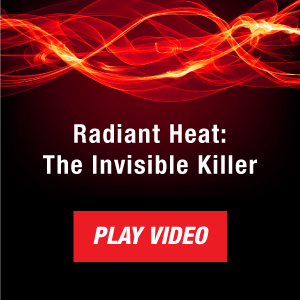Radiant Heat: The Invisible Killer | Article
Where There’s Smoke, There’s Fire. Where There’s fire, There’s the Deadly Threat of Radiant Heat. Find Solution.
Where there’s smoke, there’s fire. Where there’s fire, there’s the deadly threat of radiant heat.
When you warm yourself in front of a fireplace, you experience radiant heat firsthand. In small doses, radiant heat can be warm and welcoming, but the amount of radiant heat generated by an uncontrolled fire can be a serious threat to life safety and property.
Here’s what happens: fire emits electromagnetic radiation that travels in invisible waves through space. When these waves hit a combustible material or a person, the radiant energy is absorbed and converted into heat. When radiant heat is absorbed by a combustible material, the object catches fire when the material’s ignition temperature is reached. Protecting people from radiant heat is vital because exposed individuals quickly feel unbearable pain, followed by second-degree burns, making safe egress impossible.
Because the effects of radiant heat are life-threatening and potentially devastating, current IBC model building codes require that fire-rated glazing assemblies serving as walls, floors, or ceilings must meet ASTM E-119/NFPA 251/UL 263, which limits the temperature-rise on the non-fire side to no more than an average 250 degrees F above ambient. Setting temperature-rise limits on the non-fire side glazing surface essentially limits the allowable amount of radiant heat transmittance and ensures that occupants can exit the building safely or seek safe harbor while awaiting rescue. These applications are normally found in stairwells, fire barriers and fire walls.
But what about exit corridors with 45 minute fire rated glass in windows and sidelites – shouldn’t building occupants passing through these corridors to exit the building be safely protected from radiant heat as well? In the US, 45 minute fire rated glass used in windows and sidelites is tested to NFPA 257/UL 9, and these standards require the glazing to block the passage of flames without any mandatory measurement of radiant heat flux or non-fire side surface temperatures. This allows glazed openings in interior walls to serve as passageways through which radiant heat enters the corridor to potentially burn building occupants or ignite combustible materials like wood, drapes, paper, etc.
In this short video, Daniel Klingebiel, facilities supervisor at the National Center for International Schools in San Francisco, expressed his concern about the radiant heat passing through the sidelites that reach all the way to floor level. So when the school underwent a renovation, Daniel decided to replace the existing wired glass with tempered fire rated glass that provided impact safety and radiant heat protection.

Perhaps it’s time that test standard development committees consider how they can spur growth within the fire-rating glazing industry while improving public safety.
To learn more about fire-rated fenestration, please enroll in one of our free interactive webinars.